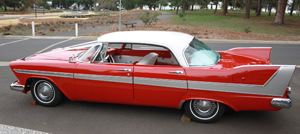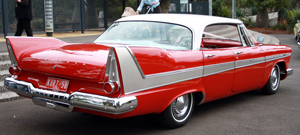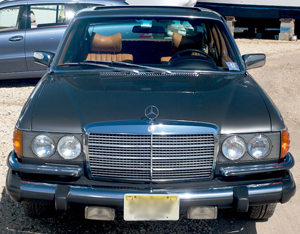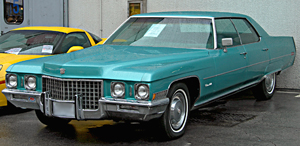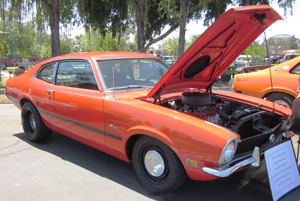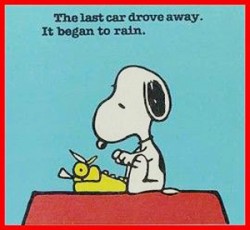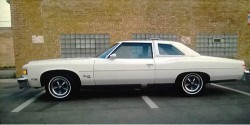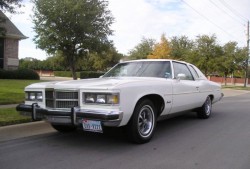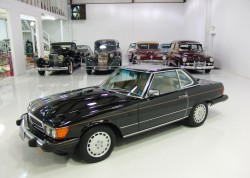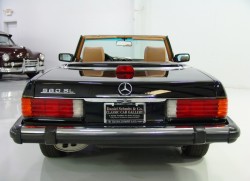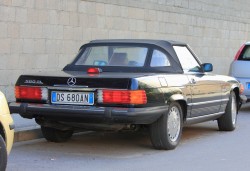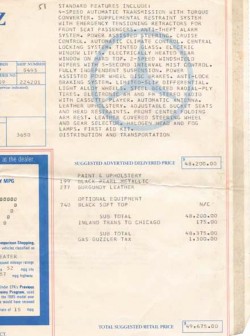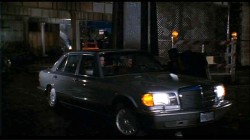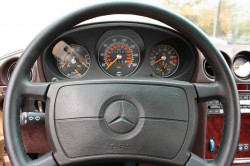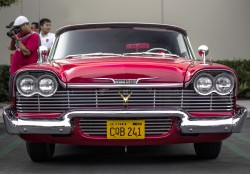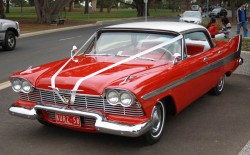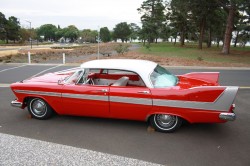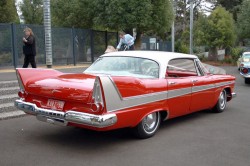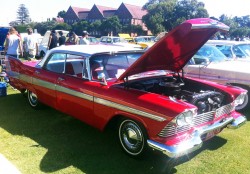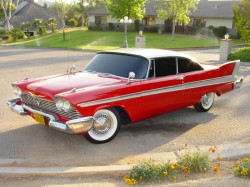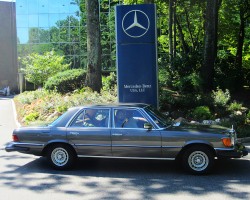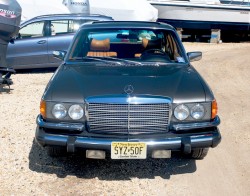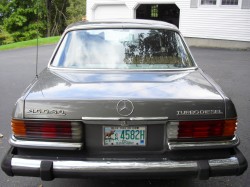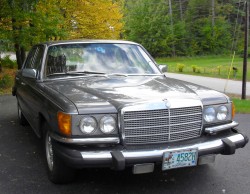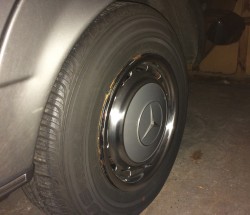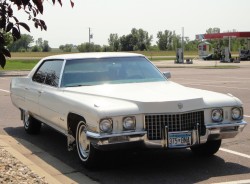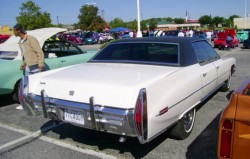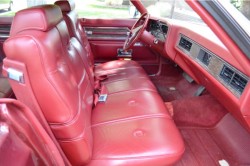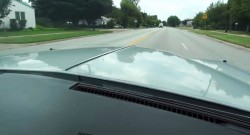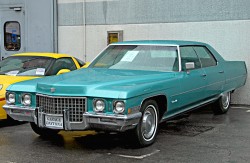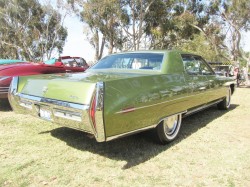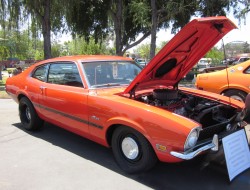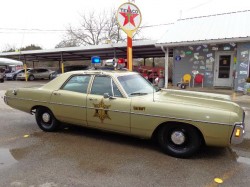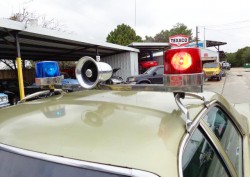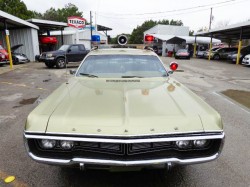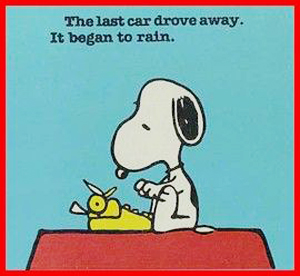 My wife paused from reading a Sue Grafton novel to ask me, “Could a Mercedes sedan that would have been around in 1988 do a tire-smoking burnout, on a smooth cement parking garage surface?” Having owned and driven a succession of older 1980s era Mercedes models, she knew she’d never encountered one. “Well, if it was an early-’70s 300SEL 6.3 or maybe a later-’70s 450SEL 6.9, maybe.”
My wife paused from reading a Sue Grafton novel to ask me, “Could a Mercedes sedan that would have been around in 1988 do a tire-smoking burnout, on a smooth cement parking garage surface?” Having owned and driven a succession of older 1980s era Mercedes models, she knew she’d never encountered one. “Well, if it was an early-’70s 300SEL 6.3 or maybe a later-’70s 450SEL 6.9, maybe.”
Those models were low-production versions of standard S-class sedans that had large (for any decade) V-8 engines stuffed under the hood. Both of them commanded extremely high price tags, and were rare enough that the sight of one would have been a once-in-a-blue-moon kind of thing. Neither were your everyday Mercedes sedan that you’d be likely to come across. In other words, special cars that only an enthusiast would seek out – during any time period. Nobody ever owned a 6.3 or a 6.9 by accident.
 When my wife indicated she was reading a paragraph from the novel V is for Vengeance, which was written in 2011 but set in 1988, I asked her, “Was the car a 300E or a 190E with a stick shift? It’d be possible in one of those.” She scanned the book for such clues but found the author had supplied no details about the car other than it being a black Mercedes sedan, and that a woman driving it in the story had tried to mow down a female private eye who was the main character of the book – fishtailing in reverse across a parking garage.
When my wife indicated she was reading a paragraph from the novel V is for Vengeance, which was written in 2011 but set in 1988, I asked her, “Was the car a 300E or a 190E with a stick shift? It’d be possible in one of those.” She scanned the book for such clues but found the author had supplied no details about the car other than it being a black Mercedes sedan, and that a woman driving it in the story had tried to mow down a female private eye who was the main character of the book – fishtailing in reverse across a parking garage.
Thinking about it more, I commented, “If it was an S-class, a big one, the author probably would have described it as a big Mercedes. They always do.” So if it wasn’t an S-class sedan, it wouldn’t have had a V8. Mercedes engines always made good horsepower for their day, but they produced horsepower that translated to high speed at high revvs on a highway, not tire smoking burnouts that would cause a fishtail. And if you’ve ever tried to find a U.S.-market 300E or 190E with a stick shift, you know that 99% of them were built with automatic transmissions. I wondered if the author had any clue of these details. Mercedes-Benzes with enough power to do tire-melting burnouts were common by 2011, so maybe Sue Grafton just assumed without researching it that anything up to 1988 would have been the same.
 If you’re like me when you read a work of fiction, you visualize things you read to a high degree. You form a mental picture of characters in the story based on people you know or know of. You visualize a setting with details in it that stir emotions. And if there are any automobiles that make an appearance somewhere across the pages, you want them to be described well enough to figure out the make, model, and year. Because being a car fanatic, you simply want to know. You value when the author describes them well, and your patience grows short when they don’t. When you realize a detail is inaccurate, you’re forced to either suspend disbelief, ignore it, or overrule it by willfully picking another detail for your mind’s eye to hold onto.
If you’re like me when you read a work of fiction, you visualize things you read to a high degree. You form a mental picture of characters in the story based on people you know or know of. You visualize a setting with details in it that stir emotions. And if there are any automobiles that make an appearance somewhere across the pages, you want them to be described well enough to figure out the make, model, and year. Because being a car fanatic, you simply want to know. You value when the author describes them well, and your patience grows short when they don’t. When you realize a detail is inaccurate, you’re forced to either suspend disbelief, ignore it, or overrule it by willfully picking another detail for your mind’s eye to hold onto. 
My wife’s question got me thinking about my own favorite authors that have written novels in the last three decades where a car makes a significant enough appearance on the pages to be described. I left off automotive journalists or writers of repair manuals, historical books, and reference guides because their whole point is to be specific in the details. No, I kept it to fiction authors who focus on telling another story – where the automobile is only secondary. Below are some of them, graded on the A-B-C-D-F scale for no other reason than to set some standards in our own minds…
Tom Wolfe, The Bonfire of the Vanities – 1987
 (Originally written during July 1984 through August 1985 in installments for Rolling Stone Magazine, Tom Wolfe revised his first fiction novel heavily during 1986 before its release in 1987. Wolfe describes two cars in the story – that of the main character Sherman McKoy, and of Circuit Court Judge Ivan Kovitsky who he later faces. When top Wall Street bond trader McCoy is picking up his mistress from JFK Airport, both of them have an accidental hit and run after making a wrong turn off the expressway into the Bronx. While Sherman’s car is only partially described in the story, the details supplied lead to an easy deduction that it’s a then-new 1986 Mercedes 560SL. The book is packed with sharp-witted humor regarding Wall Street and New York City at the time, and other characters in the book give the reader a real feel for what it was like.
(Originally written during July 1984 through August 1985 in installments for Rolling Stone Magazine, Tom Wolfe revised his first fiction novel heavily during 1986 before its release in 1987. Wolfe describes two cars in the story – that of the main character Sherman McKoy, and of Circuit Court Judge Ivan Kovitsky who he later faces. When top Wall Street bond trader McCoy is picking up his mistress from JFK Airport, both of them have an accidental hit and run after making a wrong turn off the expressway into the Bronx. While Sherman’s car is only partially described in the story, the details supplied lead to an easy deduction that it’s a then-new 1986 Mercedes 560SL. The book is packed with sharp-witted humor regarding Wall Street and New York City at the time, and other characters in the book give the reader a real feel for what it was like.
I’ll start with a description of the Circuit Court judge character’s car, as described by the Assistant District Attorney. “Practically ten years old” and “five-foot wide door” along with other descriptors allows us to picture Judge Kovitsky’s car quite accurately. Given the period of time the story was written during 1985-86, the car can be no other than a 1975-76 Bonneville coupe (the two years are almost identical visually). A 1977 model would have been smaller, with doors that were not of the length described by the author. We’ll give Tom Wolfe a B- grade overall instead of an A because while both vehicles were described accurately, it still required research to be sure of the year and exact configuration he was referring to. And no 560SLs, or any Mercedes roadsters costing $48k new, were ever available with a manual transmission described below.)
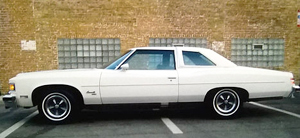
Pontiac Bonnevilles from 1971-76 were about 19 feet long, making Wolfe’s description of “20 foot frigate” pretty much on the money. And although full-size Pontiacs were substantially downsized for 1977, other American cars of this extra-large length and width were produced through the end of 1979. So he was describing something like this ’76 model.
…Kramer had just set foot on the street when a big white Pontiac Bonneville came barreling by, a real boat, with prodigious overhangs, front and back, the kind of twenty-foot frigate they stopped making about 1980. It came screeching and nose-diving to a stop on the far corner. The Bonneville’s door, a gigantic expanse of molded sheet metal, about five feet wide, opened with a sad torque pop, and a judge named Myron Kovitsky climbed out. He was about sixty, short, thin, bald, wiry, with a sharp nose, hollow eyes, and a grim set to his mouth. Through the back window of the Bonneville, Kramer could see a silhouette sliding over into the driver’s seat vacated by the judge. That would be his wife.
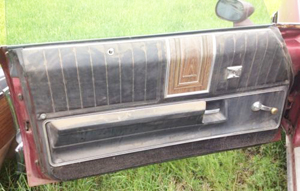
Doors on 1975-76 Pontiac Bonneville coupe models WERE extremely long and heavy, and many of them suffered from sagging hinges if rust got a foothold. Wolfe’s description of the five-foot-long doors making “a sad torque pop” and “thwock” noises when opening was completely accurate. We can conclude the car described was a coupe, not a sedan.
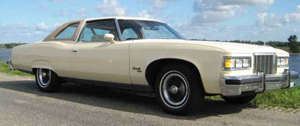
Given the period Wolfe wrote Bonfire of the Vanities (during 1985-86) along with the description “practially ten years old”, it can be concluded with certainty Judge Kovitsky’s car was no other than a 1975-76 Bonneville coupe (’76 shown here).
The sound of the enormous old car door opening and the sight of this little figure getting out were depressing. The judge, Mike Kovitzky, comes to work in a greaser yacht practically ten years old. As a Supreme Court judge, he made $65,100. Kramer knew the figures by heart. He had maybe $45,000 left after taxes. For a sixty-year-old man in the upper reaches of the legal profession, that was pathetic. Downtown…they were paying people right out of law school that much to start. And this man whose car goes thwop every time he opens the door is at the top of the hierarchy here in the island fortress. He, Kramer, occupied some uncertain position in the middle. If he played his cards right and managed to ingratiate himself with the Bronx Democratic organization, this – thwop – was the eminence to which he might aspire three decades from now. In a later scene…
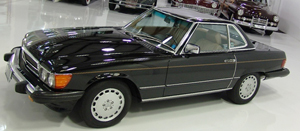
Wolfe describes Sherman McCoy’s car as “a black Mercedes two-seat sports roadster”. Considering McCoy had an annual income of over $1 million and no reference was made to the car being any kind of vintage classic, it was likely a newer model. At that point in time, the only Mercedes model matching that description was an SL. (1986 560SL shown)
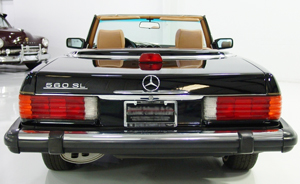
The main character was nervous about leaving his car unattended in a JFK Airport parking spot, and his fear of it being a prime theft target above virtually all others allows an assumption that it was a relatively new Mercedes two-seater. (1986 560SL shown)
…The noise of airliners taking off pounded down so hard, he could feel it. The air was full of jet fumes. The stench cut straight through to his stomach. Cars kept popping up from out of the mouth of a ramp and threading their way through the swarms of people who were roaming about on the roof in the dusk looking for the elevators or their cars or other people’s cars – Steal! Steal! Steal! – and his would be the leading candidate, wouldn’t it? Sherman stood with with one hand resting on the door, wondering if he dared leave it here. The car was a black Mercedes two-seat sports roadster that had cost $48,000 – or $120,000, according to how you wanted to look at it. In a Master of the Universe tax bracket, with federal, New York State, and New York City taxes to pay, Sherman had to make $120,000 in order to have $48,000 left to spend on a two-seat sports roadster. How would he explain it to Judy if the thing were stolen from up here on the roof of a terminal at Kennedy Airport?…Sherman lifted his Yale chin against the tide.
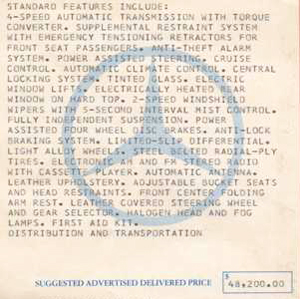
In describing Sherman McCoy’s car, Wolfe was specific about a sticker price of $48,000. The exact base sticker price of a 1986 Mercedes 560SL was $48,200. Since a comparable 1985 SL model stickered for $43,820 and a 1987 SL stickered for $55,320, the vehicle in question was a 1986.
…“Sherman, I’m sure that’s the turnoff to Manhattan.” “You’re right, sweetheart, but there’s no way I can get over there now.” “Where does this go?” “The Bronx”…His sense of direction was slipping away. His entire stock of landmarks was gone, left behind. At the end of the bridge the expressway split into a Y…He veered right again…EAST 138th…a ramp…All at once there was no more ramp, no more clean cordoned expressway. He was at ground level. It was as if he had fallen into a junkyard…
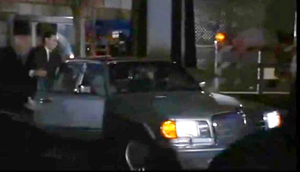
When Bonfire of the Vanities was made into a movie in 1991, Tom Hanks was cast as Sherman McCoy and Melanie Griffith was cast as Maria. His car in the movie was not an SL two-seat roadster, but a new 1991 560SEL sedan – probably because it commanded a higher price tag than any other Mercedes at that time. We have to agree it does seem more fitting for a Wall Street master of the universe.
… He turned around, toward the Mercedes. Two figures. Two young men – black – on the ramp, coming up behind him. “Yo!” said the big one. “Need some help?” Sherman stood there, holding the tire and staring. It was a neighborly voice. Setting me up! One hand inside his jacket pocket. But he sounds sincere…A sound filled his skull, the sound of rushing steam. He held the tire up in front of his chest. Now! Bango – he charged at the big one and shoved the tire at him. A sprawl – the brute fell over the tire… “Sherman!”
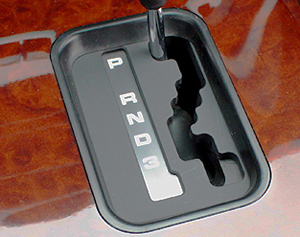
The manual transmission shifting described in the story would not have been possible in reality, because no Mercedes 560SLs were ever equipped with stick shifts. This is the 4-speed automatic trans gear shift lever McCoy’s ’86 560SL would have actually had in it.
Maria was behind the wheel of the car. The engine was roaring. The door on the passenger side was open. “Get in!” The other one, the skinny one, was between him and the car…Sherman was pure frenzy, he lowered his head and crashed into him. The boy went spinning back and hit the rear of the car but didn’t fall down…The roaring engine, the Panzer-head Mercedes dials, a blur outside the car. Sherman grabbed the door pull and with a tremendous adrenal burst banged it shut…The big one was coming toward the car. He had the tire up over his head. Maria squealed the car forward, right at him. He lurched out of the way while the tire hit the windshield and bounced off without breaking the glass – the Krauts! Maria cut the the wheel to the left, to keep from hitting the cans…The rear 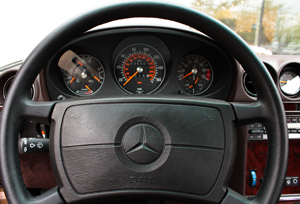 end fishtailed…thok! The skinny boy was no longer standing. She floored it – a furious squeal – the Mercedes shot up the ramp and the road rose beneath them…A blaring horn swerved and hurtled past, and they were out on the expressway…Maria had on an Avenue Foch royal-blue jacket with shoulder pads out to here, a tense little animal writhing under royal-blue shoulder pads from Paris. The two of them in a $48,000 Mercedes with spiffy airplane dials, desperate to escape the Bronx. The author’s description of stalling the vehicle, using the emergency brake, and shifting into first and second gears is the only detail that rings false. No 560SLs sold anywhere in the world were available with manual transmissions – only automatics. While United States import laws through 1986 would have allowed Sherman McCoy to import a six-cylinder 1986 300SL with a manual transmission from Europe, the sticker price of such a car would have been far lower than $48,000.
end fishtailed…thok! The skinny boy was no longer standing. She floored it – a furious squeal – the Mercedes shot up the ramp and the road rose beneath them…A blaring horn swerved and hurtled past, and they were out on the expressway…Maria had on an Avenue Foch royal-blue jacket with shoulder pads out to here, a tense little animal writhing under royal-blue shoulder pads from Paris. The two of them in a $48,000 Mercedes with spiffy airplane dials, desperate to escape the Bronx. The author’s description of stalling the vehicle, using the emergency brake, and shifting into first and second gears is the only detail that rings false. No 560SLs sold anywhere in the world were available with manual transmissions – only automatics. While United States import laws through 1986 would have allowed Sherman McCoy to import a six-cylinder 1986 300SL with a manual transmission from Europe, the sticker price of such a car would have been far lower than $48,000.
Stephen King, Christine –1983
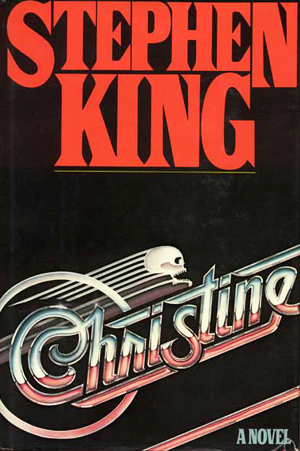 This story takes place during the summer of 1978 through the early months of 1979 in a middle-class suburb of Pittsburgh, Pennsylvania. In the beginning of the story, the main character, (Arnie Cunningham) spots a dilapidated 1958 Plymouth Fury for sale at the residence of a seventy-one-year old man (Roland LeBay) in the December of his years. Because it’s the summer of 1978, the ’58 Fury’s two decades on earth make it old enough to be registered as a classic – something Arnie thinks of as perfect entering his senior year of high school. Arnie falls instantly in love with the car (known as “Christine”) and has to have it despite the protests of his parents and his best buddy Dennis, whose perspective the story is told from. As Arnie begins to work on the car, he struggles to understand how areas of it are getting fixed and replaced when he doesn’t remember making the repairs himself. At the same time, his pimply complexion clears up, and his nerdy persona is replaced by a far more confident one. A beautiful new girl in school who only knows Arnie as he’s become finds him attractive enough to become his first girlfriend, and he finds more courage to stand up to school thugs that bully him.
This story takes place during the summer of 1978 through the early months of 1979 in a middle-class suburb of Pittsburgh, Pennsylvania. In the beginning of the story, the main character, (Arnie Cunningham) spots a dilapidated 1958 Plymouth Fury for sale at the residence of a seventy-one-year old man (Roland LeBay) in the December of his years. Because it’s the summer of 1978, the ’58 Fury’s two decades on earth make it old enough to be registered as a classic – something Arnie thinks of as perfect entering his senior year of high school. Arnie falls instantly in love with the car (known as “Christine”) and has to have it despite the protests of his parents and his best buddy Dennis, whose perspective the story is told from. As Arnie begins to work on the car, he struggles to understand how areas of it are getting fixed and replaced when he doesn’t remember making the repairs himself. At the same time, his pimply complexion clears up, and his nerdy persona is replaced by a far more confident one. A beautiful new girl in school who only knows Arnie as he’s become finds him attractive enough to become his first girlfriend, and he finds more courage to stand up to school thugs that bully him.
After the leader of the tough kids gets expelled for pulling a knife on Arnie, they trash the ’58 Fury. It soon becomes apparent the car is possessed and can exact revenge on its own – repairing itself as needed and becoming a rider on Arnie’s soul. Stephen King’s ability as a storyteller in the details makes this one of his best works, even if you’re not a car fan. Since the car was so clearly described and easy to visualize, we’ll give King an A- grade overall. The only glitch: Unlike the movie which featured a two-door hardtop coupe, Arnie’s ’58 Plymouth in the book was a four-door in every reference except a one that described it as a “sport coupe”. Stephen King didn’t realize until the movie was made that the Fury was a coupe-only version of the standard Belevedere model series. Perhaps that’s why the movie featured coupes only
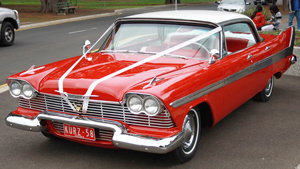
Unlike the 1984 movie, the 1958 Plymouth Fury in Stephen King’s book “Christine” was actually described as a four-door in almost every reference. The author did not distinguish whether it was a sedan with pillars between the doors, or whether it was a hardtop sedan model with no door posts (shown above). We’ll assume it was a hardtop model, simply because they look so much better. In reality, the Fury model was only sold as a coupe.
Arnie had fallen in love with a 1958 Plymouth Fury, one of the long ones with the big fins. There was an old and sun-faded FOR SALE sign propped on the right side of the windshield – the side that was not cracked. “Look at her lines, Dennis!” Arnie whispered. He was running around the car like a man possessed. His sweaty hair flew and flopped. He tried the back door on the passenger side, and it came open with a scream. “Arnie, you’re having me on, aren’t you?” I said. “It’s sunstroke, right? Tell me it’s sunstroke. I’ll take you home and put you under the air conditioner and we’ll forget about all this, okay?”… He didn’t even bother to reply. A hot, stuffy billow of air, redolent of age, oil, and advanced decomposition puffed out of the open door. Arnie didn’t seem to notice that either. He got in and sat down on the ripped and faded back seat. Once, twenty years before, it had been red. Now it was a faded wash pink… “Son, have you ever owned a car before?”
“No,” Arnie said quietly. “I just got my driver’s license this spring.” LeBay touched the old, scuffed hood of the Plymouth with a kind of bemused love. “This here is the best car I ever owned. Bought her in September 1957. Back then, that’s when you got your new model year, in September. All summer long they’d show you pictures of cars under tarps until you were fair dyin t’know what they looked like underneath. Not like now.” His voice dripped contempt for the debased times he had lived to see. “Brand new, she was. Had the smell of a brand new car, and that’s about the finest smell in the world…I walked into Norman Cobb’s Plymouth dealership – where the bowling alley is now on outer Main Street – and I ordered this here car. I said you get it in red and white, next year’s model. Red as a fire engine on the inside. And they did it. When I got her, she had a total of six miles on the odometer. Yessir.”
… I walked through the breezeway to the garage and tried the door. It ran up easily and exhaled the same odors I had smelled when I had opened the Plymouth’s door yesterday – oil, old upholstery, and the accumulated heat of a long summer…In the center, nose outward, sat Arnie’s car, Christine, looking a mile long in this day and age when even Cadillacs looked squeezed together and boxy.
… It didn’t take long to catch up with Arnie. He was pulled into the curb, and Christine’s trunk lid was up. An automobile jack so old that it almost looked as if it might once have been used for changing wheels on Conestoga wagons was leaning against the crooked back bumper. The right rear tire was flat…. We used my jack to get the Plymouth up (for several horrible seconds I thought the rear bumper was going to rip off in a screech of decaying metal) and pulled the dead tire. We got the new one on, tightened the lug nuts some, and then let it down. It was a great relief to have the car standing on the street again; the way that rotted bumper bent up under the jack had scared me.
“There,” Arnie said, clapping the ancient, dented hubcap back on over the lug nuts. I stood looking at the Plymouth, and the feeling I’d had in LeBay’s garage suddenly recurred. The blackwall still had one of the manufacturer’s stickers on it and the bright yellow chalk marks from the gas-jockey’s hurried wheel balancing. I shivered a little – but to convey the sudden weirdness I felt would be impossible. It was as if I had seen a snake that was almost ready to shed its old skin, that some of that old skin had already flaked away, revealing the glistening newness underneath.
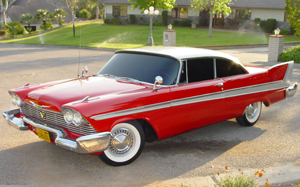
Stephen King makes one accidental reference to the ’58 Plymouth in the book as a “sport coupe”. Above, a ’58 Fury Sport Coupe similar to how it was cast in the 1984 movie.
… LeBay’s brother recollected “My brother was not a good man. I believe the only thing he ever truly loved in his whole life was that Plymouth Fury your friend has purchased…When my brother finally left the Army in 1957, Veronica had put away a little over twelve hundred dollars. Adding to it was a substantial disability pension for his back injury – he fought for it and won, he said. So the money was finally there. They got the house you and your friend visited, but before the house was even considered, of course, the car came. The car was always paramount. The visits to the dealerships reached a fever pitch. And at last he settled upon Christine. I got a long letter about her. She was a 1958 Fury sport coupe and he gave me all the facts and figures in his letter.” 
… Still, I wanted to look under the hood. More than ever. I went around to the driver’s side door and gave it a yank. The door didn’t open. It was locked. Of course it was; all four of the door lock buttons were down …Locking the Fury’s doors was a very natural thing to do, all right. Except that, when I walked around the car the first time, I thought I had noticed the door lock buttons had all been up.
…“I understand they punched holes in the body with some sharp instrument,” Detective Junkins said, looking closely at Christine’s flank. “I’ll be damned if I can see the fill. You must be a bodywork genius, Arnie”… “You can see the bodywork if you really look for it.” He pointed at a minute ripple in Christine’s back deck. “And there.” He pointed at another. “I was lucky enough to find some original Plymouth body parts up in Ruggles. I replaced the entire back door on this side. You see the way the paint doesn’t quite match?”
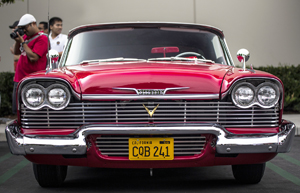
Stephen King was ten years old when 1958 models hit the showrooms – the age when the most lasting impressions are typically formed among automobile fanatics. It’s easy to tell that King is a fellow fanatic and that the menacing-looking front end of 1957-59 Plymouth Fury models made a lasting impression in his mind.
…The Camaro swapped ends, and now the headlights of the car following blared directly into them, and Buddy began to scream because it was Arnie’s car, all right, that grille was impossible to mistake, it seemed at least a mile wide, only there was no one behind the wheel. The car was totally empty.
Stephen King, You Know They’ve Got a Hell of a Band – 1992
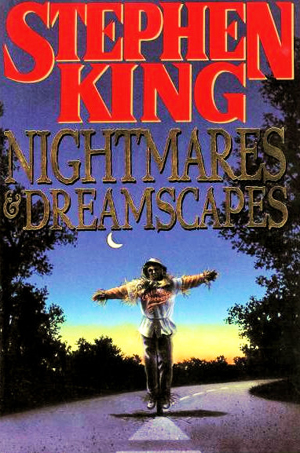 In this short story that’s part of a compilation Nightmares and Dreamscapes, Stephen King again makes enough references to a specific car to intrigue those who appreciate such things. In You Know They’ve Got a Hell of a Band, Clark and Mary Willingham are a couple traveling through Oregon in 1992 that plan to visit a town called Toketee Falls. Clark is being transferred out of state, so they opt to take a more scenic route through deeply forested woods. As Mary protests about the possibility they might become lost in the remote wilderness, Clark adamantly maintains his course down the ever-worsening dirt road while his wife takes a nap.
In this short story that’s part of a compilation Nightmares and Dreamscapes, Stephen King again makes enough references to a specific car to intrigue those who appreciate such things. In You Know They’ve Got a Hell of a Band, Clark and Mary Willingham are a couple traveling through Oregon in 1992 that plan to visit a town called Toketee Falls. Clark is being transferred out of state, so they opt to take a more scenic route through deeply forested woods. As Mary protests about the possibility they might become lost in the remote wilderness, Clark adamantly maintains his course down the ever-worsening dirt road while his wife takes a nap.
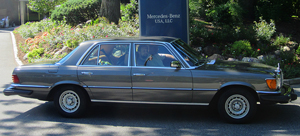
We’ll give Stephen King a B- grade, since it would take higher knowledge or research to deduce that “The Princess” in this story would be a gray Mercedes 300SD Turbodiesel of 1978-80 vintage.
When Mary wakes and confronts him, he finally admits that he’s given up hope of finding Toketee Falls and that, furthermore, he had the opportunity to turn around and rejected it. The car (described as “The Princess”) that the couple is traveling in is described with enough clues to allow a deductive, knowledgeable reader to piece together exactly what the model is and how it would look. Astute Stephen King fans will notice that he seems to have a penchant for large gray Mercedes S-Class models – featuring them in this and two other stories during the 1980s-90s, and in a starring role in his 2014 book “Mr. Mercedes” which has been made into a multiple-season television series on the Peacock network.
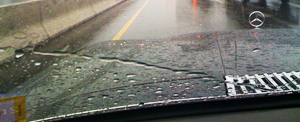
A view from the driver’s seat one would enjoy in any “116-body” Mercedes S-class model of 1973-80 vintage.
We have no doubt that the details he describes on 1970s and 80s Benz diesels are nuances that only come from having owned and lived with one or several of them. Certainly Mr. King could have afforded any cars he wanted then, and surely he bought a few out of the showroom. We’ll give Stephen a B- grade in this story, since most details were accurate yet incomplete. It would take higher knowledge or research to deduce that the Princess would be a Mercedes 300SD Turbodiesel of 1978-80 vintage. There were still plenty of these “116-body” Benzes in service in 1992 because their durability made them age to a lesser extent than most vehicles, and it’s perfectly believable that a couple like Clark and Mary would have held onto a model that was 12+ years old.
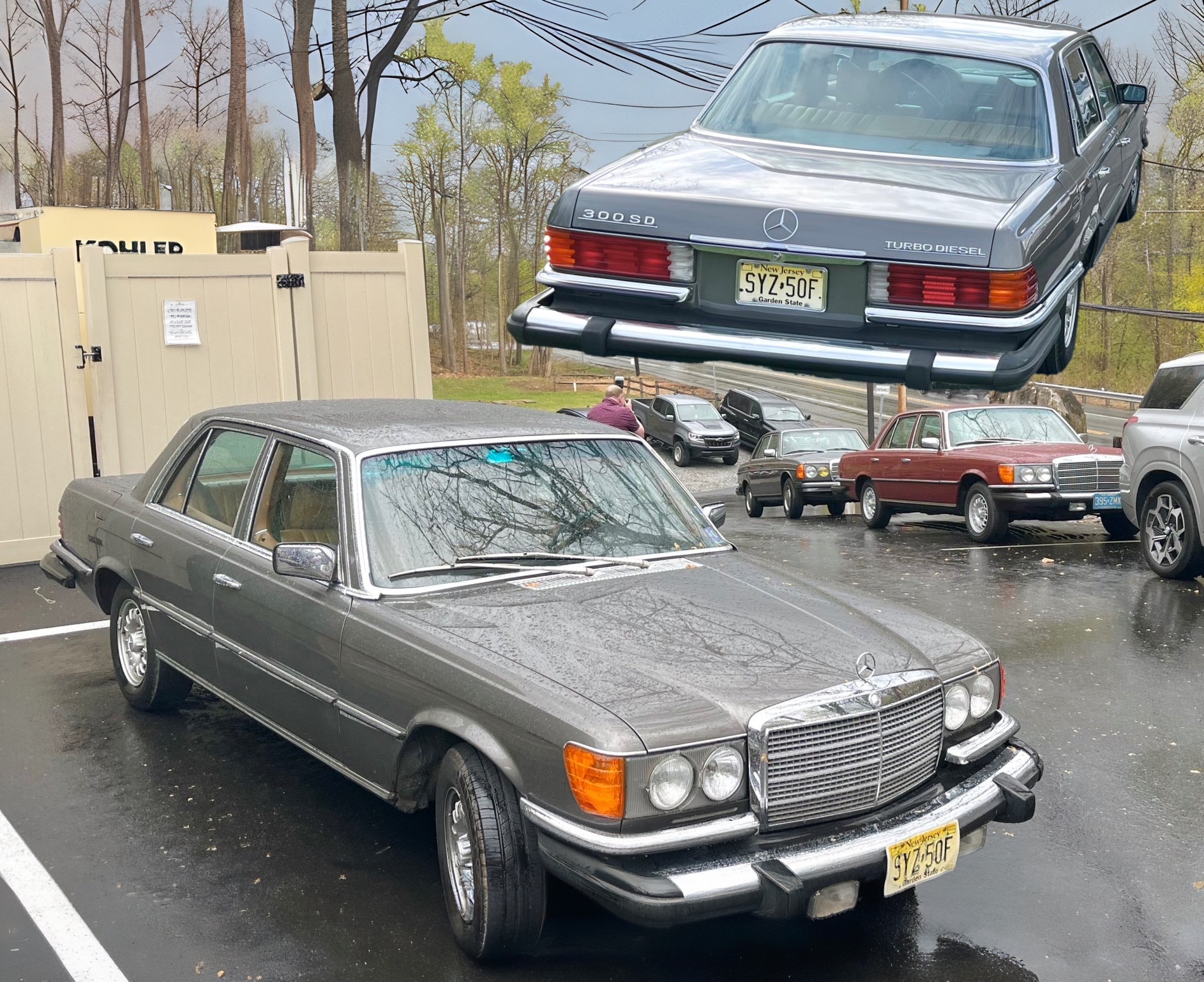
“Rough rumble of the diesel engine”, “The Princess’s normally sedate diesel engine gave a low scream and shot forward”, and “The Princess was gaining speed as all diesels do – not fast, but with relentless strength – and chumming a dark brown cloud of exhaust behind her” are exact characteristics of Benz’s 5-cylinder turbo diesel engine used from 1978-85. “Big gray Mercedes” indicates an S-class model such as this 1978 300SD.
…There really was no place to turn around. If he tried to do it, he would mire the Princess to her hubcaps in one of the marshy ditches which bordered this miserable excuse for a road … She punched the eject button. The tape belched out, followed by an ugly brown afterbirth – coils of shiny tape.
He stopped the Mercedes, which now straddled the entire road, slammed the transmission into Park, and got out…The rough rumble of the diesel engine served to emphasize the wall of quiet encircling them. She looked across the Princess’s gray roof at Clark… The big gray Mercedes, looking very much out of place, began to creep down the shadowy track again. … She could still see the Mercedes’s distinctive grille and peace-sign hood ornament still outside…
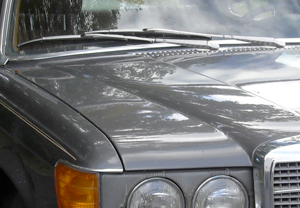
The fact that somebody, or some thing, riding on the hood of the car could easily grab onto the wipers means that the car was a 116-body Mercedes S-class of 1973-80 vintage. Since diesel engines were not available in that body style before 1978, “The Princess” was definitely a 1978, 1979, or 1980 model. The next generation Mercedes S-class had recessed wipers under the hood that would be very hard to reach.
…He found drive and floored the accelerator. The Princess’s normally sedate diesel engine gave a low scream and shot forward. She snatched the seat belt buckle and jammed it home, watching with horrified fascination as the thing on the hood reached forward with its left hand and grabbed the windshield wiper in front of her. It began to haul itself forward. The wiper snapped off. The thing on the hood glanced at it, tossed it overboard, and reached for the wiper on Clark’s side. Before he could get it, Clark tramped on the brake again …the thing on the hood was thrown clear of the car and landed in the street. Then two tons of German engineering hit him and bore him under….
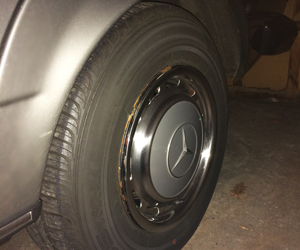
The only possible glitch in King’s otherwise accurate description of the car was the use of “hub caps”. If by hubcaps he meant wheel covers, 300SDs from 1978-80 came with aluminum wheels standard, not wheel covers. Of course, it’s possible it could have been retrofitted with a set of these shown here. Or it’s possible he meant hub caps as in the center cap of the aluminum wheels.
…The Princess was gaining speed as all diesels do – not fast, but with relentless strength – and chumming a dark brown cloud of exhaust behind her…. Clark swung the Princess into the curve without slowing, and on the far side, there was a bus blocking the road…Clark gave it his best, but wasn’t quite able to stop. The Princess slid into the Magic Bus at ten or fifteen miles an hour, her wheels locked and her tires smoking fiercely. …There was a hollow bang as the Mercedes hit the tie-dyed bus amidships. Mary was thrown forward against her safety harness again. The bus rocked on its springs a little, but that was all… The Princess’s engine sounded choppy, and Mary could see steam escaping from around the front of her crumpled hood. When Clark dropped the transmission lever into reverse, the car backfired twice, shuddered like an old wet dog, and stalled.
Harry Crews, “CAR” – 1970
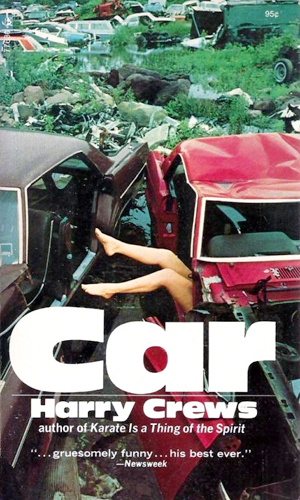 Born in 1935 in Georgia, Harry Crews served in the United States Marines during the Korean War, received a Masters Degree in English Education, and later became an English professor at the University of Florida. During his lifetime, Crews was a prolific novelist with a hard boiled writing style and raw wit that comes across as ingeniously humorous.
Born in 1935 in Georgia, Harry Crews served in the United States Marines during the Korean War, received a Masters Degree in English Education, and later became an English professor at the University of Florida. During his lifetime, Crews was a prolific novelist with a hard boiled writing style and raw wit that comes across as ingeniously humorous.
In his 1970 novel Car which takes place during the summer and fall of that year, we see a family with the last name of Mack that’s built an auto salvage yard into a profitable business. The father (named Easy), his two twin sons Herman and Mister, and daughter Junelle are all expert mechanics and car enthusiasts – much like Harry Crews himself. Herman, always the renegade of the family, hatches a moneymaking scheme with a large hotel owner where he will physically consume a new 1971 Ford Maverick coupe a tiny bit at a time each day.
After a small bit of the car is cut off, sanitized, and welded into a small smooth ball, Herman consumes it in front a paying audience. As he later passes each lump of metal, a metal press machine re-stamps it into the shape of a keyring-size Ford Maverick that’s bid off to an enthusiastic audience – highly fictional as it may be. Once Herman begins to make serious money, the family gets more involved. Having come across countless wrecked and old Cadillacs in the scrap yard, they can now afford to buy the car they’ve always wanted – a new Cadillac.
Crews’s description of the 1971 Cadillac Sedan de Ville they purchase is accurate in all ways even though he does not mention if the new car has a plain painted roof or vinyl-covered one. Color of the vinyl roof was an important factor in car choice back then, as over 90% of 1971 models were equipped with them. I also enjoy Crews’s descriptions of the 1971 Maverick, and of Junelle’s boyfriend Joe’s state police cruiser that he patrolled the highways in. We’ll give Crews a two-part grade of A on the Cadillac and Maverick, with a D on the police cruiser because it was simply described as a “Chrysler”.
ON CADILLACS IN GENERAL… …Easy Mack wished he had something to say, but he didn’t. He had said the car would save them all. Back when Junell and Herman and Mister were just little things, and their mother was alive, he had said that America was a V-8 country, gas-driven and water-cooled, and that it belonged to men who belonged to cars. He believed it all those years as a shade-tree mechanic, and he believed it when he got the job as a shop foreman in the new-car dealership in Waycross Georgia, and he still believed it when he got his chance and bought the forty-three acres and started Auto-Town, even though a junked car put through the crusher, packaged and delivered to the barge, only brought fifty cents per hundred pounds…
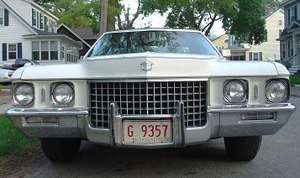
Front view of a white 1971 Cadillac Sedan de Ville, similar to one that the Mack family purchased new as soon as they became of means.
Cadillac: the poor man’s car (Once you git yourself one of them babies, you got youself something. Your regular Cadillac is a pree-cision-made machine. Low upkeep. No depreciation to speak of hardly).
Cadillac: the rich man’s car (I didn’t work eighteen hours a day and get three ulcers at the age of thirty-six to drive a Volkswagen. You show me a man who can trade in for a new Cadillac in October of every year and I’ll show you a man in the mainstream of America…
…“I bought it…You know we’ve always wanted one,” said Mister. “The standard of excellence that everything’s measured against. They say so, and you’ve always said so. And we’ve finally got there. It’s ours.” It was true. Easy had always talked of owning a
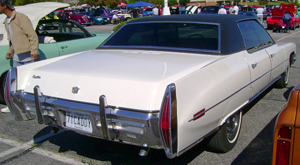
While Crews was descriptive about the 1971 Cadillac Sedan de Ville in the story, he never touched on what color the vinyl roof was or if it even had one at all.
brand-new Sedan de Ville, the most popular of Cadillac cars. But they had never really been able to afford one before. Even owning the largest junkyard in the state, there was always the taxes, and the turnover, and the overhead, and the ever-decreasing value of wrecked cars. And now there it was. It was theirs, and Easy Mack wondered why he was not happy.
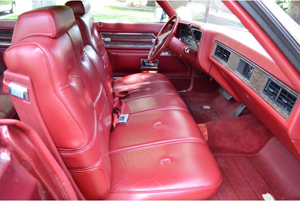
“Brand new. Nobody’s ever farted on her seat covers,” said the salesman delivering the Mack family’s new Cadillac.
The salesman led them down a hall to a floodlit area behind the dealership. In the midst of an acre of light was a white Cadillac. “There she is,” said the salesman. “Brand-new. Nobody’s ever farted on her seat covers.” He laughed long and loud at his joke. He did not seem to mind at all that Mister and his father were not laughing… The salesman opened the door on Easy Mack’s side and Easy fell into the deep cushions of the front seat. The heavy doors swung shut with the solid deep-throated click of a bank vault closing, and they felt themselves hermetically sealed from the world. Mister started the motor and they moved away from the salesman and left him standing in the white pool of light, waving. The car plunged and rose over a deep gully and was back onto the pavement. “It squeaked,” said Easy… In spite of himself, Mister cocked his head and strained to hear. Nothing came to him but the powerful purr of the engine. He smiled. “Your Cadillac does not squeak.” “This one did,” insisted Easy. “I’ll fix it,” Easy insisted. “Do you think your daddy can’t fix a squeak?” He stared his son down. “I was fixin squeaks before you were born, boy!”
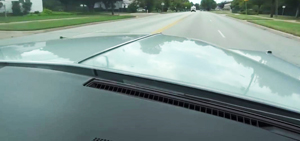
The view from the passenger seat Easy Mack would have enjoyed while trying to fix a squeak somewhere under the dash of his brand new 1971 Cadillac Sedan de Ville.
Mister found a lane for emergency parking, slowed, eased the wheel onto the dirt shoulder. “There!” cried his father. And it was true. Mister’s 1971 Cadillac car, with only twenty-one miles on the odometer, on whose seat covers no one had ever farted, squeaked… They drove all night through the dark streets of Jacksonville, stopping now and then under a street light for Easy to loosen something or tighten something or put a tiny drop of oil under or into something. At one point, he had the entire instrument panel disassembled and carefully laid out in the back seat; but when he put it all back together, the squeak was still there.
…If he had just been able to fix that squeak, it would have been different. The Cadillac had overwhelmed him. All that power. All those lights. All that everything. But then it had squeaked. The fucking thing had squeaked! It may cost ten thousand dollars and have four cigarette lighters to the square inch and more lights than you could count or ever use, but it squeaked. A man who was a mechanic. A man who controlled and understood the car. Understood its weaknesses. Its flaws. But God in heaven! He had opened up that Cadillac car and looked behind the instrument panel, and he had felt his own mortality in a way that he had never felt it before. Such a maze of wiring – blue
wires and yellow wires and red wires and green wires – and fuses of every sort! God himself would have been amazed and confused before such a thing. Or so Easy had thought. But he told himself that he had to suck it up and go. Either you mastered it or it mastered you. In a blind awful moment of perverse nonreasoning, he knew that if he couldn’t fix it, he ought to have to eat it.
JUNELLE’S BOYFRIEND’S STATE POLICE CRUISER

Harry Crews only refers to the police cruiser in the story as a “4-door Chrysler”. Since state patrol cars are typically newer, we pictured a 1970 model. And since Dodge Polaras were most favored by police departments then (actual Chrysler models were never used), we went with a 1970 Dodge Polara.
They walked over to the cruiser. It was a four-door Chrysler with a special bored and stroked engine that could produce 500 horsepower… Joe’s cruiser was part of a special force patrolling the highways of the state. A special force of special men. Not only did you have to be of a certain height and weight to be on the special force, but you also had to be a high school graduate and, finally, a great handler of cars – a natural driver.
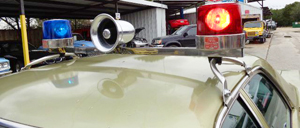
We gave Harry Crews a grade of D on his description of Joe’s police cruiser because it was completely vague.
Joe had perfect vision and the reflexes of a ping-pong champion. He was a mechanic who’s expertise was so great that they let him build and modify his own car. Before joining the highway patrol he had been known and feared on dirt-tracks and back streets all over the Southeast.
…Junell loved to hear about that car, that Chrysler cruiser. He’d talk about how it had run that morning, how he’d stopped and made a minute adjustment on one of the two four-barrel carburetors. His voice would get high and urgent as he put together the story of a chase: laying a hundred-yard streak of rubber, a curve taken in a power slide, maybe – once in awhile – a few bullets would come flying back at him from the car he was chasing, then he’d whip out his special tire-shooting gun, a thirty-ought-six, and blast the tires off the car he was chasing (his ping-pong champion reflexes never failed him) and watch the car swerve, roll over, vault into the air and, if he was lucky, explode.
…And she would take the profession of his respect without saying anything as not to interrupt the story of the car, anxious as she was for him to get back to tune-ups, adjustments, new speed equipment he’d found for his supercar to make it even more super, faster, and more powerful.
Continued in Part 2 (click here to see)
BELOW ARE FULL-SIZE IMAGES OF THE ONES FEATURED ABOVE IN THE ARTICLE. CLICK ON ANY ONE TO OPEN, THEN USE SMALL ARROW BUTTONS UNDER EACH PICTURE TO SCROLL BACK AND FORTH.
- 1976 PONTIAC BONNEVILLE
- 1976 PONTIAC BONNEVILLE
- 1986 MERCEDES 560SL
- 1986 MERCEDES 560SL
- 1986 MERCEDES 560SL
- A 1986 MERCEDES 560SL base sticker price was $48,200
- In the 1991 movie Bonfire of the Vanities, the main character drove a Mercedes 560SEL sedan.
- 1986 MERCEDES 560SL “airplane dial” instrument cluster
- 1958 PLYMOUTH FURY
- 1958 PLYMOUTH BELVEDERE hardtop sedan
- 1958 PLYMOUTH BELVEDERE hardtop sedan
- 1958 PLYMOUTH BELVEDERE hardtop sedan
- 1958 PLYMOUTH BELVEDERE hardtop sedan
- Chrysler caught its bigger competitors napping when 1957 Plymouth, Dodge, DeSoto, and Chrysler mainstream models increased vehicle length and width while moving from 2 to 4 headlights and adding fins – something the others wouldn’t do to their basic cars until 1958.
- 1979 MERCEDES 300SD
- Hood view of a 1978 MERCEDES 300SD
- 1979 MERCEDES 300SD
- 1980 MERCEDES 300SD
- 1980 MERCEDES 300SD
- 14-inch color matched Mercedes wheel cover
- 1971 CADILLAC SEDAN de VILLE
- 1971 CADILLAC SEDAN de VILLE
- 1971 CADILLAC SEDAN de VILLE interior
- 1971 CADILLAC SEDAN de VILLE
- 1971 CADILLAC SEDAN de VILLE with painted roof
- 1971 CADILLAC SEDAN de VILLE with finished roof
- 1971 FORD MAVERICK
- 1970 DODGE POLARA state trooper vehicle
- 1970 DODGE POLARA state trooper vehicle
- 1970 DODGE POLARA state trooper vehicle

